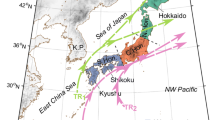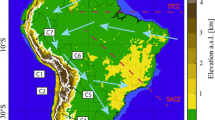Abstract
We present a detailed analysis of summer monsoon rainfall over the Indian peninsular using nonlinear spatial correlations. This analysis is carried out employing the tools of complex networks and a measure of nonlinear correlation for point processes such as rainfall, called event synchronization. This study provides valuable insights into the spatial organization, scales, and structure of the 90th and 94th percentile rainfall events during the Indian summer monsoon (June–September). We furthermore analyse the influence of different critical synoptic atmospheric systems and the impact of the steep Himalayan topography on rainfall patterns. The presented method not only helps us in visualising the structure of the extreme-event rainfall fields, but also identifies the water vapor pathways and decadal-scale moisture sinks over the region. Furthermore a simple scheme based on complex networks is presented to decipher the spatial intricacies and temporal evolution of monsoonal rainfall patterns over the last 6 decades.
















Similar content being viewed by others
References
Albert R, Barabási AL (2002) Statistical mechanics of complex networks. Rev Mod Phys 74:47
Arenas A, Díaz-Guilera A, Kurths J, Moreno Y, Zhou CS (2008) Synchronization in complex networks. Phys Rep 469(3):93–153
Bhide UV, Muzamdar R, Ghanekar SP, Paul DK, Chen TC, Rao GV (1997) A diagnostic study on heat sources and moisture sinks in the monsoon trough area during active break phase of the Indian monsoon of 1979. Tellus Ser A Dyn Meteorol Oceanol 49:455–473
Boccaletti S, Latora V, Moreno Y, Chavez M, Hwang DU (2006) Complex networks: structure and dynamics. Phys Rep 424(4–5):175–308
Bookhagen B (2010) Appearance of extreme monsoonal rainfall events and their impact on erosion in the himalaya. Geomat Nat Hazards Risk 1:37–50
Bookhagen B, Burbank DW (2006) Topography, relief, and trmm-derived rainfall variation along the himalaya. Geophys Res Lett 33:L08405
Bookhagen B, Burbank DW (2010) Toward a complete himalayan hydrological budget: spatiotemporal distribution of snowmelt and rainfall and their impact on river discharge. J Geophys Res 115:F03019
Coles S, Heffernan J, Tawn J (1999) Dependence measures for extreme value analyses. Extremes 2(4):339–365
Coles S (2001) An introduction to statistical modeling of extreme values. Springer, Berlin
Dangalchev C (2006) Residual closeness in networks. Phisica A 365(2):556–564
Davison AC, Hinkley D (2006) Bootstrap methods and their application, 8th edn. Cambridge University Press, Cambridge
Dimri AP (2004) Impact of horizontal model resolution and orography on the simulation of a western disturbance and its associated precipitation. Meteorol Appl 11:115–127
Ding Y, Sikka DR (2006) Synoptic systems and weather. In: Wang B (ed) The Asian monsoon. Springer, Berlin
Donges JF, Zou Y, Marwan N, Kurths J (2009) The backbone of the climate network. EPL 87(4):48007
Donges JF, Schultz HCH, Marwan N, Zou Y, Kurths J (2011) Investigating the topology of interacting networks—theory and application to coupled climate subnetworks. Eur Phys J B. doi:10.1140/epjb/e2011-10899-1
Fasullo J, Webster PJ (2003) A hydrological definition of Indian monsoon onset and withdrawal. J Clim 16:3200–3211
Gadgil S (2003) The Indian monsoon and its variability. Annu Rev Earth Planet Sci 31:429–467
Goswami BN, Venugopal V, Sengupta D, Madhusoodanan MS, Xavier Prince K (2006) Increasing trend of extreme rain events over India in a warming environment. Science 314:1442–1445
Groisman PY, Karl TR, Easterling DR, Knight RW, Jamason PF, Hennessy KJ, Suppiah R, Page CM, Wibig J, Fortuniak K et al (1999) Changes in the probability of heavy precipitation: important indicators of climatic change. Clim Change 42(1):243–283
Hong C-C, Hsu H-H, Lin N-H, Chi H (2011) Roles of European blocking and tropical? extratropical interaction in the 2010 Pakistan flooding. Geophys Res Lett 38:L13806
Houze RA, Wilton DC, Smull BF (2007) Monsoon convection in the Himalayan region as seen by the TRMM Precipitation Radar. Q J R Meteorol Soc 133:1389–1411
Johnson RH (2006) Mesoscale processes. In: Wang B (ed) The Asian monsoon. Springer, Berlin
Keshavamurthy RN (1973) Power-spectra of large scale disturbances of the Indian south-west monsoon. Indian J Meteorol Geophys 24:117–124
Kripalani RH, Kulkarni A (1999) Rainfall variability over south-east Asia—connections with Indian monsoon and enso extremes: new perspectives. Int J Climatol 17(11):1155–1168
Krishnmurthy V, Shukla J (2000) Interseasonal and inter annual variability of rainfall over India. J Clim 13:4366–4377
Kumar KK, Rajagopalan B, Cane M (1999) On the weakening relationship between the Indian monsoon and enso. Science 284(5423):2156–2159
Kumar KK, Rajagopalan B, Hoerling M, Bates G, Cane M (2006) Unraveling the mystery of Indian monsoon failure during el niño. Science 314(5796):115–119
Lenton TM, Held H, Kriegler E, Hall JW, Lucht W, Rahmstorf S, Schellnhuber HJ (2008) Tipping elements in the earth’s climate system. PNAS 105(6):1786–1793
Lenton TM (2011) Early warning of climate tipping points. Nat Clim Change 1:201–209
Levermann A, Schewe J, Petoukhov V, Held H (2009) Basic mechanism for abrupt monsoon transitions. PNAS 106(49):20572–20577
Malik N, Marwan N, Kurths J (2010) Spatial structures and directionalities in monsoonal precipitation over south Asia. Nonlinear Process Geophys 17:371–381
Maraun D, Kurths J (2005) Epochs of phase coherence between el nino/southern oscillation and Indian monsoon. Geophys Res Lett 32:L15709
May W (2004) Simulation of the variability and extremes of daily rainfall during the Indian summer monsoon for present and future times in a global time-slice experiment. Clim Dyn 22:183–204
May W (2004) Variability and extremes of daily rainfall during the Indian summer monsoon in the period 1901–1989. Glob Planet Change 44:83–105
Mokhov II, Smirnov DA, Nakonechny PI, Kozlenko SS, Seleznev EP, Kurths J (2011) Alternating mutual influence of el-nino southern oscillation and Indian monsoon. Geophys Res Lett 38:L00F04
Mooley DA, Shukla J (1989) Main features of the westwerd moving low pressure systems which form over the Indian region which form over the Indian region during the monsoon season and their relationship with monsoonal rainfall. Mausam 40:137–152
Newman MEJ (2003) The structure and function of complex networks. SIAM Rev 45(2):167–256
Parthasarathy B, Munot AA, Kothawale DR (1995) Monthly and seasonal rainfall series for all-India homogeneous regions and meteorological subdivisions: 1871–1994. Contributions from Indian Institute of Tropical Meteorolgy, Research Report RR-065, Aug. 1995, Pune 411 008 India
Quian Quiroga R, Kreuz T, Grassberger P (2002) Event synchronization: a simple and fast method to measure synchronity and time delay patterns. Phys Rev E 66:041904-1
Ramanathan V, Chung C, Kim D, Bettge T, Buja L, Kiehl JT, Washington WM, Fu Q, Sikka DR, Wild M (2005) Atmospheric brown clouds: impact on south Asian climate and hydrologic cycle. PNAS 102:5326–5333
Rajeevan M, Bhate J, Jaswal AK (2008) Analysis of variability and trends of extreme rainfall events over India using 104 years of gridded daily rainfall data. Geophys Res Lett 35:L18707
Roe GH (2005) Orographic precipitation. Annu Rev Earth Planet Sci 33:64571
Schumacher C, Houze RA (2003) Stratiform rain in the tropics as seen by the trmm precipitation radar. J Clim 16:1739–1756
Sikka DR (1977) Some aspects of the life history, structure and movement of monsoon depressions. Pure Appl Geophys 115:1501–1529
Stephenson DB, Rupa Kumar K, Doblas-Reyes FJ, Royer JF, Chavin F (1999) Extreme rainfall events and their impact on ensemble forecasts of Indian monsoon. Mon Weather Rev 127:1954–1966
Steinbach M, Tan PN, Kumar V et al (2003) Discovery of climate indices using clustering. In: Proceedings of the ACM SIGKDD conference on knowledge discovery and data mining, pp 446–455
Steinhaeuser K, Chawla NV, Ganguly AR (2010) An exploration of climate data using complex networks. ACM SIGKDD Explor 12:25–32
Swanson KL, Tsonis AA (2009) Has the climate recently shifted? Geophys Res Lett 36:L06711
Tsonis AA, Swanson KL (2008) Topology and predictability of el nino and la niña networks. Phys Rev Lett 100(22):228502
Tsonis AA, Swanson KL, Roebber PJ (2006) What do networks have to do with climate? Bull Am Meteorol Soc 87(5):585
Tsonis AA, Wang G, Swanson KL, Rodrigues F, Costa L (2010) Community structure and dynamics in climate networks. Clim Dyn. doi:10.1007/s00382-010-0874-3
Waliser DE (2006) Interseasonal variability. In: Wang B (ed) The Asian monsoon. Springer, Berlin
Wang B (ed) (2006) The Asian monsoon. Springer, Berlin
Watts DJ, Strogatz SH (1998) Collective dynamics of small-world networks. Nature 393(6684):440–442
Webster PJ (1987) The elementary monsoon. In: Fein JS, Stephens PL (eds) Monsoons. Wiley, New York
Webster PJ, Magana VO, Palmer T, Shukla J, Tomas RA, Yani M, Yasunari T (1998) Monsoons: Processes, predictability, and the prospects for prediction. J Geophys Res 103:14,451–14,510
Wulf H, Bookhagen B, Scherler D (2010) Seasonal precipitation gradients and their impact on fluvial sediment flux in the northwest himalaya. Geomorphology 118:13–21
Yamasaki K, Gozolchiani A, Havlin S (2008) Climate networks around the globe are significantly affected by el niño. Phys Rev Lett 100(22):22850
Yanai M, Wu G (2006) Effects of the tibetan plateau. In: Wang B (ed) The Asian monsoon. Springer, Berlin
Yatagai A, Arakawa O, Kamiguchi K, Kawamoto H (2009) A 44 year daily gridded precipitation dataset for Asia based on dense network of rain gauges. SOLA 5:137–140
Zickfeld K, Knopf B, Petoukhov V, Schellnhuber HJ (2005) Is the Indian summer monsoon stable against global change? Geophys Res Lett 32:L15707
Acknowledgments
This work is supported by a doctoral scholarship from the DFG Graduate School 1364. The authors thank Dr. Yong Zou, Jonathan F. Donges and Arghya Mondal for helpful discussion.
Author information
Authors and Affiliations
Corresponding author
Rights and permissions
About this article
Cite this article
Malik, N., Bookhagen, B., Marwan, N. et al. Analysis of spatial and temporal extreme monsoonal rainfall over South Asia using complex networks. Clim Dyn 39, 971–987 (2012). https://doi.org/10.1007/s00382-011-1156-4
Received:
Accepted:
Published:
Issue Date:
DOI: https://doi.org/10.1007/s00382-011-1156-4




